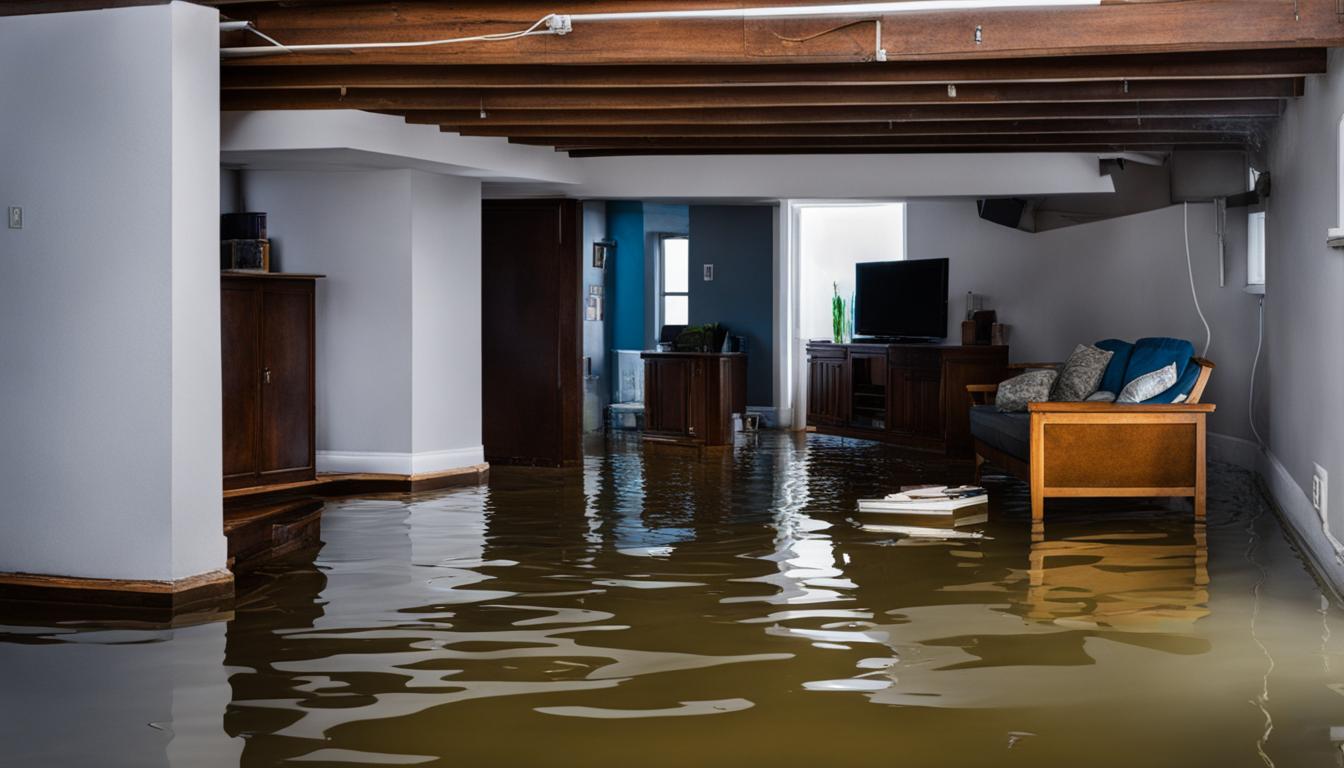Water damage can have disastrous consequences for your property and belongings. Whether it’s a burst pipe, a leaky roof, or a natural disaster, water intrusion can cause significant structural damage, as well as health hazards from mold growth and bacteria. In this section, we will delve into the causes and effects of water damage and explore ways to prevent and mitigate its effects.
Key Takeaways
- Water damage can have severe consequences on both your property and health
- Common causes of water damage include burst pipes, leaky roofs, and natural disasters
- Water can damage building materials, furnishing, and lead to mold growth
- Water damage can lead to costly repairs and replacements
- Mitigating the effects of water damage requires swift action and adequate insurance coverage
Common Causes of Water Damage
Water damage can be caused by a variety of factors, ranging from natural disasters to plumbing issues within your home. Here are some of the most common water damage causes:
| Cause | Description |
|---|---|
| Burst Pipes | Extreme temperatures can cause pipes to freeze and burst, leading to significant water damage. |
| Leaky Roofs | Roof leaks can occur due to various reasons, such as heavy rainfall, missing shingles, or improper installation, leading to water infiltration into your home. |
| Plumbing Issues | Issues with plumbing systems, such as clogs, leaks, and backups, can cause water damage within your home. |
| Natural Disasters | Natural disasters like floods, hurricanes, and storms can cause extensive damage to homes and properties, leading to potential water infiltration and damage. |
Regardless of the cause, it is crucial to address any water damage issues promptly to avoid further damage and mitigate potential hazards.
Structural Damage from Water Intrusion
Water damage to buildings can have significant consequences on their structural integrity. Water intrusion can weaken the foundation, damage walls and ceilings, and compromise the overall structural design. Failure to address water damage to buildings promptly can lead to severe and costly repairs.
Structural water damage is often accompanied by visible signs, such as cracks in the walls, uneven floors, or sagging ceilings. However, sometimes the damage is hidden, making it challenging to detect until it is too late. Such hidden water damage can cause rot and decay of the wood frame, significantly weakening the building structure.
Ignoring structural water damage can lead to catastrophic results. The building may collapse or require extensive repairs, which can be costly and time-consuming. Moreover, untreated water damage can cause mold growth, which can lead to additional structural damage and health risks.
| Consequences of Structural Water Damage | Signs of Structural Water Damage |
|---|---|
| Collapsing walls and ceilings | Cracks in walls and ceilings |
| Weakened structural foundation | Sagging ceilings |
| Rot and decay of wood structures | Uneven floors |
| Expensive repairs | Bowed walls |
It is essential to address water damage to buildings as soon as possible. Call a professional restoration company to assess the damage and provide effective solutions. Timely restoration can prevent further damage and save you money in the long run.
Damages to Building Materials and Furnishings
Water damage can have devastating effects on building materials and furniture. When water infiltrates your home or business, it can cause damage to building elements such as wood, drywall, and insulation. Furniture, carpets, and other household items can also be severely affected, leading to costly repairs or replacements.
Water damage to building materials can weaken the structural integrity of your home or business. For instance, compromised drywall can create weakness in walls and ceilings, compromising their strength and stability. In addition, prolonged water exposure can lead to potential hazardous mold growth, damaging building materials and further compromising the safety of your property.
Your furniture and personal belongings can also be severely impacted by water damage. Water can create discoloration, weakening structural integrity, and destroying finishes. Additionally, water can cause or exacerbate odor issues. Prolonged water exposure can lead to mold growth, posing a health hazard, which can further damage building materials and be a breeding ground for bacteria.
The Impact on Building Materials:
| Building Material | Effects of Water Damage |
|---|---|
| Wood | When wood is exposed to water, it may warp, buckle, or suffer discoloration. It can also weaken the structural strength of the materials and create wood rot, which could render the surface unusable and hazard |
| Drywall | Discoloration and weakness, creating vulnerability, in addition, can present potential mold issue and potentially harbor toxic substances that could pose risks to human health |
| Insulation | Affected by dampness, creating mold, it is in existence of moisture, reduce and lose efficiency, and lead to increased energy costs. |
The Impact on Furnishings:
- Water can create streaks and water lines on fabrics.
- Water can weaken the structural integrity of wood and cause finishes to peel, leading furniture to become damaged.
- Carpets can be ruined by water damage, causing discoloration and staining, developing mold issue, and creating offensive odors.
To prevent water damage to your home or business, it’s vital to contact skilled professionals who specialize in water damage restoration. A rapid and professional approach can lessen the impact of potential issues and reduce the damage to your building and belongings. After any incidence of water damage, it is essential to act quickly to mitigate any potential damage and prevent mold growth.
Health Risks and Mold Growth
When water damage occurs, it can not only damage your property but also pose significant health risks. Prolonged exposure to water damage can lead to respiratory issues, allergic reactions, and other health concerns. One of the most significant health risks associated with water damage is mold growth.
Mold thrives in damp environments and can spread quickly, causing a range of health problems, including respiratory issues, headaches, and fatigue. It can also exacerbate existing health conditions, such as asthma and allergies. Mold spores can travel through the air and settle on surfaces, making it difficult to eradicate once it has taken hold.
The best way to prevent mold growth is to address water damage promptly. When you notice signs of water intrusion, such as damp spots or musty odors, act quickly to identify and eliminate the source of the problem. Cleaning up the water damage as soon as possible can prevent mold growth and minimize health risks.
If you suspect you have mold growth in your home due to water damage, it’s essential to take action immediately. Depending on the severity of the mold growth, you may need to consult with a professional remediation service to ensure safe and thorough removal.
Financial Consequences of Water Damage
Water damage can have a significant financial impact on homeowners. Not only do water-related repairs and restoration costs add up quickly, but the potential loss of valuables can be devastating.
Without adequate insurance coverage, homeowners may find themselves bearing the full financial burden of water damage. It is crucial to understand what your insurance policy covers and ensure that you have enough coverage to protect yourself in case of an incident.
| Policy Type | Coverage Details |
|---|---|
| Homeowners Insurance | Covers water damage caused by specific perils, such as burst pipes, leaks, or storms. However, not all policies cover flood damage. |
| Flood Insurance | Covers flood water damage caused by natural disasters, such as hurricanes and heavy rains, that exceed normal water levels. Requires a separate policy and is not typically included in homeowners insurance. |
| Sewer Backup Insurance | Covers water damage caused by sewer backups, which can occur due to clogged pipes or heavy rainfall. Must be added as a specific endorsement to a homeowners insurance policy. |
Make sure you review your insurance coverage regularly and consider increasing coverage limits if necessary. Taking preventative measures, such as regular property inspections and maintenance, can also help mitigate the risk of water damage and potential financial consequences.
Conclusion
Water damage can have significant consequences on your property and belongings. Understanding the causes and effects of water damage is crucial for prevention and swift mitigation in case of an incident. By identifying common sources of water damage, you can take proactive measures to safeguard your property. In the event of water intrusion, prompt action to address the issue can help minimize the potential hazards of water damage.
Furthermore, the impact of water damage extends beyond the physical damage to your property. Prolonged exposure to water damage can lead to respiratory issues, allergic reactions, and other health concerns. Additionally, water damage can have severe financial consequences, including repairs, restoration costs, and potential loss of valuables. It is essential to have adequate insurance coverage to mitigate the financial burden of water damage.
In summary, water damage is a serious issue that should not be taken lightly. Educate yourself on the causes and effects of water intrusion, take proactive measures to prevent water damage, and act swiftly in addressing any water-related issues that may arise. By doing so, you can protect your property, your health, and your financial well-being.
FAQ
What are the common causes of water damage?
The common causes of water damage include burst pipes, leaky roofs, plumbing issues, and natural disasters like flooding.
How does water intrusion damage the structure of buildings?
Water intrusion can weaken foundations, compromise walls and ceilings, and lead to structural damage in buildings.
What building materials and furnishings are susceptible to water damage?
Various building materials such as wood, drywall, and insulation can be damaged by water. Furniture, carpets, and other household items are also vulnerable to water damage.
Are there health risks associated with water damage?
Yes, prolonged exposure to water damage can lead to mold growth and the spread of bacteria, which can cause respiratory issues and allergic reactions.
What are the financial consequences of water damage?
The financial consequences of water damage include repair and restoration costs, as well as potential loss of valuables. It is important to have adequate insurance coverage to mitigate these financial burdens.
How can I prevent water damage to my property?
To prevent water damage, it is important to address any plumbing issues promptly, maintain your roof in good condition, and ensure proper drainage around your property. Regular inspections and maintenance can help identify and mitigate potential risks.






















